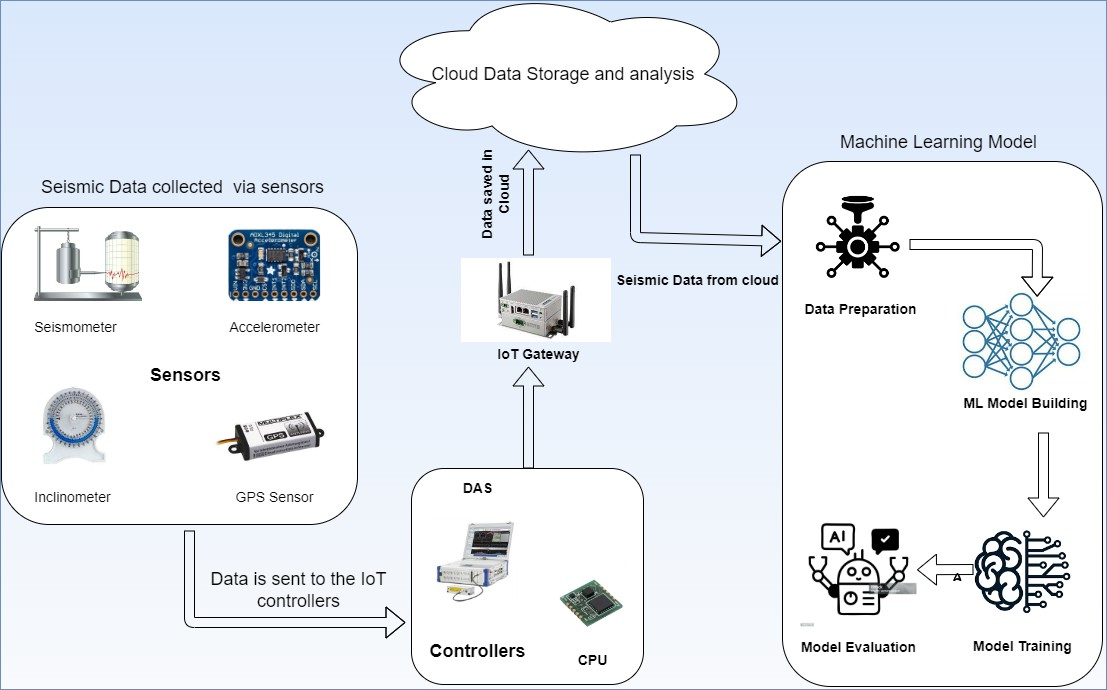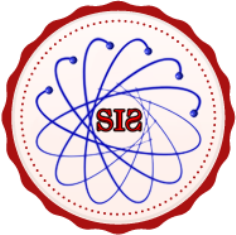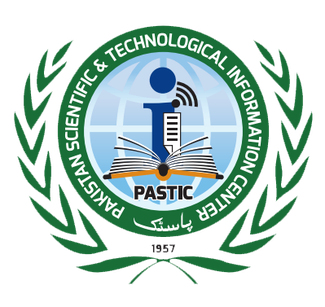Seismic Data Analysis and Earthquake Prediction with IoT Sensors and SmartGRU Model
Keywords:
Earthquake prediction, Seismic Data Fusion, Internet of Things (IoT), Bidirectional Gated Recurrent UnitAbstract
Tectonic plate movement causes a slow accumulation of stress in the Earth’s lithosphere, especially around plate borders, leading to earthquakes. An earthquake occurs when this stress overcomes friction along a fault or exceeds the strength of the surrounding rock. Accurate earthquake prediction remains challenging due to the complexity of seismic data and the limitations of traditional methods. This creates a pressing need for models capable of real-time analysis and high prediction accuracy. The Internet of Things (IoT) provides a novel method for detecting earthquakes using a variety of sensors to collect vital seismic data, such as latitude, longitude, depth, magnitude, and time. IoT controllers and centralized systems process and analyze this data to enable efficient monitoring and forecasting. Furthermore, with the help of a machine learning model named Bidirectional Gated Recurrent Unit (Bi-GRU), which integrates sophisticated data fusion and advanced machine learning techniques. Our proposed study model, SmartGRU, demonstrates how to improve earthquake prediction systems by combining IoT sensors with a Bi-GRU machine learning model that incorporates an emerging approach.
References
D. Shanker and M. L. Sharma, “Estimation of seismic hazard parameters for the Himalayas and its vicinity from complete data files,” Pure Appl. Geophys., vol. 152, no. 2, pp. 267–279, 1998, doi: 10.1007/S000240050154.
K. Fauvel et al., “A Distributed Multi-Sensor Machine Learning Approach to Earthquake Early Warning,” Proc. AAAI Conf. Artif. Intell., vol. 34, no. 01, pp. 403–411, Apr. 2020, doi: 10.1609/AAAI.V34I01.5376.
D. Zhang et al., “Evaluation of a Sensor System for Detecting Humans Trapped under Rubble: A Pilot Study,” Sensors 2018, Vol. 18, Page 852, vol. 18, no. 3, p. 852, Mar. 2018, doi: 10.3390/S18030852.
K. Wang, J. Zhang, J. Zhang, Z. Wang, and Z. Li, “An envelope-based machine learning workflow for locating earthquakes in the southern Sichuan Basin,” Earthq. Res. Adv., vol. 4, no. 2, p. 100252, Apr. 2024, doi: 10.1016/J.EQREA.2023.100252.
S. Pirasteh and J. Li, “Landslides investigations from geoinformatics perspective: quality, challenges, and recommendations,” Geomatics, Nat. Hazards Risk, vol. 8, no. 2, pp. 448–465, Dec. 2017, doi: 10.1080/19475705.2016.1238850;SUBPAGE:STRING:FULL.
V. N. Deekshit, M. V. Ramesh, P. K. Indukala, and G. J. Nair, “Smart geophone sensor network for effective detection of landslide induced geophone signals,” Int. Conf. Commun. Signal Process. ICCSP 2016, pp. 1565–1569, Nov. 2016, doi: 10.1109/ICCSP.2016.7754422.
Z. Li, “Recent advances in earthquake monitoring II: Emergence of next-generation intelligent systems,” Earthq. Sci., vol. 34, no. 6, pp. 531–540, Dec. 2021, doi: 10.29382/EQS-2021-0054.
B. Tian, W. Liu, H. Mo, W. Li, Y. Wang, and B. R. Adhikari, “Detecting the Unseen: Understanding the Mechanisms and Working Principles of Earthquake Sensors,” Sensors 2023, Vol. 23, Page 5335, vol. 23, no. 11, p. 5335, Jun. 2023, doi: 10.3390/S23115335.
R.M. Allen, “Advancements in seismic monitoring: High resolution seismogram analysis and earthquake detection,” Rev. Geophys., vol. 60, 2022.
H. Kanamori, “Seismological observations and theories: From the seismograph to earthquake prediction,” Annu. Rev. Earth Planet. Sci., vol. 49, pp. 61–89.
C. M. Rosca and A. Stancu, “Earthquake Prediction and Alert System Using IoT Infrastructure and Cloud-Based Environmental Data Analysis,” Appl. Sci. 2024, Vol. 14, Page 10169, vol. 14, no. 22, p. 10169, Nov. 2024, doi: 10.3390/APP142210169.
Z. T. AlAli and S. A. Alabady, “A survey of disaster management and SAR operations using sensors and supporting techniques,” Int. J. Disaster Risk Reduct., vol. 82, p. 103295, Nov. 2022, doi: 10.1016/J.IJDRR.2022.103295.
“Gated Recurrent Neural Networks Empirical Utilization for Time Series Classification | IEEE Conference Publication | IEEE Xplore.” Accessed: Jun. 17, 2025. [Online]. Available: https://ieeexplore.ieee.org/document/8875282
H. Han et al., “Advanced series decomposition with a gated recurrent unit and graph convolutional neural network for non-stationary data patterns,” J. Cloud Comput., vol. 13, no. 1, pp. 1–19, Dec. 2024, doi: 10.1186/S13677-023-00560-1/FIGURES/7.
Y. Kong et al., “Unlocking the Power of LSTM for Long Term Time Series Forecasting,” Aug. 2024, Accessed: Jun. 17, 2025. [Online]. Available: https://arxiv.org/pdf/2408.10006
P. Pierleoni, R. Concetti, S. Marzorati, A. Belli, and L. Palma, “Internet of Things for Earthquake Early Warning Systems: A Performance Comparison Between Communication Protocols,” IEEE Access, vol. 11, pp. 43183–43194, 2023, doi: 10.1109/ACCESS.2023.3271773.
M. S. Abdalzaher, M. Krichen, D. Yiltas-Kaplan, I. Ben Dhaou, and W. Y. H. Adoni, “Early Detection of Earthquakes Using IoT and Cloud Infrastructure: A Survey,” Sustain. 2023, Vol. 15, Page 11713, vol. 15, no. 15, p. 11713, Jul. 2023, doi: 10.3390/SU151511713.
A. Alphonsa and G. Ravi, “Earthquake early warning system by IOT using Wireless sensor networks,” Proc. 2016 IEEE Int. Conf. Wirel. Commun. Signal Process. Networking, WiSPNET 2016, pp. 1201–1205, Sep. 2016, doi: 10.1109/WISPNET.2016.7566327.
A. Alsehaimi, M. Houda, A. Waqar, S. Hayat, F. Ahmed Waris, and O. Benjeddou, “Internet of things (IoT) driven structural health monitoring for enhanced seismic resilience: A rigorous functional analysis and implementation framework,” Results Eng., vol. 22, p. 102340, Jun. 2024, doi: 10.1016/J.RINENG.2024.102340.
N. N. V. Gupta, M. S. Rinesh, and U. G. Scholar, “IOT BASED EARTHQUAKE DETECTION BY THINGSPEAK”, Accessed: Jun. 17, 2025. [Online]. Available: http://www.acadpubl.eu/hub/
F.e Khan, “Machine learning for earthquake prediction: Applications of lstm and cnns,” Earthq. Sci. J., vol. 17, no. 2, pp. 211–224.
J. Jia and W. Ye, “Deep Learning for Earthquake Disaster Assessment: Objects, Data, Models, Stages, Challenges, and Opportunities,” Remote Sens., vol. 15, no. 16, Aug. 2023, doi: 10.3390/RS15164098/S1
R.e Dutta, “Seismic data analysis for earthquake prediction in the asia-himalaya region,” J. Seismol. Earthq. Eng., pp. 301–315, 2021.
A.e Rashid, “Gru models for efficient earthquake prediction in time-series data,” Earth Sp. Sci., vol. 7, no. 10, pp. 515–530.
Ilham Muthahhari and Muhammad Dzakwan Firdaus, “IoT-Based Seismic Sensor Network Design for Early Warning System in Kalimantan : Literature Review,” J. Comput. Phys. Earth Sci., vol. 4, no. 2, Mar. 2025, doi: 10.63581/JOCPES.V4I2.02.
A.e Kaur, “Cloud computing for real-time seismic data processing: Addressing low-latency requirements,” J. Cloud Comput. Adv., vol. 14, no. 2, pp. 135–148.
J.K. Lee, “Real-time seismic data analysis using iot technology,” J. Geophys. Eng., vol. 72, no. 4, pp. 865–874.
R. Bhasin et al., “Landslide hazards and mitigation measures at Gangtok, Sikkim Himalaya,” Eng. Geol., vol. 64, no. 4, pp. 351–368, Jun. 2002, doi: 10.1016/S0013-7952(01)00096-5.
A.N. Chakraborty, “Advances in seismic event classification us- ing machine learning: A review,” J. Seismol., 2022.
J.P. Kim, “Multi-feature fusion networks for seismic signal classification,” Geophys. J. Int..
Z.H. Zhang, “Time-series feature engineering for seismic magnitude prediction with deep learning,” Geosci. Front..
S. M. Mousavi, W. L. Ellsworth, W. Zhu, L. Y. Chuang, and G. C. Beroza, “Earthquake transformer—an attentive deep-learning model for simultaneous earthquake detection and phase picking,” Nat. Commun., vol. 11, no. 1, Dec. 2020, doi: 10.1038/S41467-020-17591-W,.
M. Nakano, “Efficient preprocessing techniques for seismic data using 1d cnns,” J. Geophys. Res. Solid Earth.
V. Koushik, N. V. S. Sasipreetham, M. Nithya, and P. V. Manitha, “Early Detection and Warning System for Earthquakes Using Internet of Things,” Proc. - 2024 3rd Int. Conf. Sentim. Anal. Deep Learn. ICSADL 2024, pp. 529–533, 2024, doi: 10.1109/ICSADL61749.2024.00092.
“Magnitude and intensity: Measures of earthquake size and severity,” Earthq. Inf. Bull., vol. 14, no. 6, pp. 209–219, 1982.
X.e Yuan, “Enhancements in gru-based earthquake prediction models using bidirectional layers,” Seismol. Res. Lett., vol. 95, no. 4, pp. 982–990.
M. A. Bilal, Y. Ji, Y. Wang, M. P. Akhter, and M. Yaqub, “Early Earthquake Detection Using Batch Normalization Graph Convolutional Neural Network (BNGCNN),” Appl. Sci. 2022, Vol. 12, Page 7548, vol. 12, no. 15, p. 7548, Jul. 2022, doi: 10.3390/APP12157548.

Downloads
Published
How to Cite
Issue
Section
License
Copyright (c) 2025 50sea

This work is licensed under a Creative Commons Attribution 4.0 International License.




















